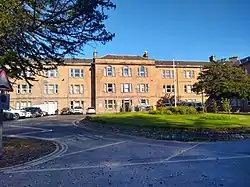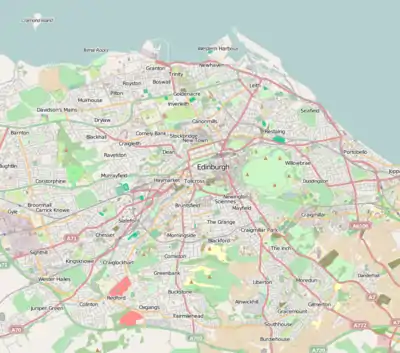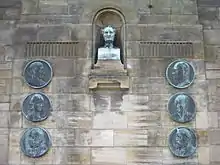Royal Edinburgh Hospital
The Royal Edinburgh Hospital is a psychiatric hospital in Morningside Place, Edinburgh, Scotland. It is managed by NHS Lothian.[1]
| Royal Edinburgh Hospital | |
|---|---|
| NHS Lothian | |
 Mackinnon House at the heart of the hospital | |
 Shown in Edinburgh | |
| Geography | |
| Location | Edinburgh, Scotland. |
| Coordinates | 55.9274°N 3.2155°W |
| Organisation | |
| Type | Psychiatric hospital |
| History | |
| Opened | 1809 |
| Links | |
| Website | www |
| Other links | List of hospitals in Scotland |
History
The "foundational myth" has it that the hospital was founded by Dr Andrew Duncan, following the death of Robert Fergusson, a Scottish poet who died in 1774 following mental health problems caused by a head injury.[2] Duncan wanted to establish a hospital in Edinburgh that would care for the mentally ill of the city and after launching an appeal in 1792 a grant of £2,000 was approved by Parliament in 1806.[2] A Royal charter was granted by King George III in 1807 and the facility was then established as a public body.[3] A villa in Morningside, along with four acres of land, was then purchased and in 1809 the foundation stone was laid[4] by Lord Provost William Coulter on 8 June 1809.[5] The facility was opened as the Edinburgh Lunatic Asylum in 1813.[6]
The asylum originally consisted of a building called East House which accepted only paying patients, but a second building called West House, designed by William Burn and commissioned to intended to accommodate poorer patients, opened in 1842.[7] The inmates of Edinburgh's bedlam were later admitted in 1844.[8]
The asylum's first Physician Superintendent Dr William MacKinnon, who took up the post in 1840,[9] encouraged patients to be active through skills and hobbies they already possessed, including gardening, pig farming, carpentry, sewing, tailoring, poultry keeping, and curling.[8][7] Shortly thereafter, in 1845, the asylum installed a printing press and the hospital began to produce a monthly magazine, the Morningside Mirror.[7] The hospital received Royal Patronage in 1841 and became the Royal Edinburgh Lunatic Asylum.[10]
The hospital joined the National Health Service in 1948 and the Andrew Duncan Clinic opened in 1965.[11] A 15 tonne work known as Abraham was carved in granite by sculptor Ronald Rae in the grounds of the hospital in 1982[12] and the Rivers Centre, a clinic for the treatment of Posttraumatic stress disorder established in memory of the pioneering psychiatrist William Rivers, opened in 1997.[13]
A modern hospital on the same site was procured under the Scottish government's non-profit distributing model in January 2015.[14][15] The first phase of the new hospital was built by Morrison Construction at a cost of £45 million and completed in January 2017.[16]
Pinel Memorial

The Pinel Memorial was erected in 1926 to commemorate the centenary of the death of Philippe Pinel, a pioneer of psychiatric care. It includes six bronze medallion heads to other principal figures in improving conditions: William Tuke, Florence Nightingale, Robert Gardiner Hill, Andrew Duncan, Dorothea Lynde Dix and Campbell Clark.[17]
Notable Staff
Notable staff have included:
- David Skae was appointed as the Physician Superintendent of the Royal Edinburgh Asylum in 1846, and he held this title until 1872.[18]
- Sir Thomas Clouston succeeded David Skae as Physician Superintendent in 1873 and remained in post until 1908.[19][20]
- Sir John Sibbald FRSE was Deputy Commissioner from 1870 to 1879 and as Commissioner from 1879 to 1899.[20]
- Dr Campbell Clark was assistant to Clouston before leaving to head the newly built Hartwood Hospital.[21]
References
- "Royal Edinburgh Hospital". NHS Lothian. 28 August 2013. Retrieved 10 June 2014.
- "Royal Edinburgh Hospital History". www.nhslothian.scot.nhs.uk. Retrieved 14 November 2018. The story has been contested by a number of modern scholars - see e.g. Barfoot, Michael. "Contested Charity: Andrew Duncan and the Edinburgh Lunatic Asylum, 1792-1828". (Royal College of Physicians of Edinburgh Archives, DEP/BAM/2.)
- LHSA. "Royal charter of the Royal Edinburgh Hospital". www.lhsa.lib.ed.ac.uk. Retrieved 14 November 2018.
- LHSA. "Royal Edinburgh Hospital collection summary". www.lhsa.lib.ed.ac.uk. Retrieved 14 November 2018.
- Grant's Old and New Edinburgh vol.5 p.39
- "Our Organisation: About Us: Our History: Royal Edinburgh Hospital History". www.nhslothian.scot.nhs.uk. NHS Lothian. 1 June 2011. Retrieved 12 December 2016.
- LHSA. "Royal Edinburgh Hospital history". www.lhsa.lib.ed.ac.uk. Retrieved 14 November 2018.
- NHS Lothian (July 2010). "The Royal Edinburgh Hospital: A guide for patients, relatives and carers" (PDF). Retrieved 14 November 2018.
- Minutes of the Managers of the Royal Edinburgh Asylum, 29 January 1840 (LHS Archives, LBH 7.1.2)
- Minutes of the Managers of the Edinburgh Lunatic Asylum, 5 February 1841 (LHS Archives, LBH 7.1.2)
- "Royal Edinburgh Hospital". Historic Hospitals. 26 April 2015. Retrieved 16 January 2019.
- "Abraham". Ronald Rae. 5 September 2009. Retrieved 10 June 2014.
- "Rivers Centre" (PDF). NHS Lothian. Retrieved 16 January 2019.
- "Galliford Try closes on £45m Edinburgh hospital". Building. 5 January 2015. Retrieved 16 January 2019.
- "Nicola Sturgeon hails £400m hospital fund". BBC News. 2 November 2014. Retrieved 2 November 2014.
- "NHS Lothian gets keys to Royal Edinburgh Hospital". Building Better Healthcare. 3 January 2017. Retrieved 16 January 2019.
- Historic Environment Scotland. "View of Philippe Pinel Memorial, in grounds of Royal Edinburgh Hospital (1226031)". Canmore. Retrieved 4 June 2019.
- BARFOOT, MICHAEL (October 2009). "David Skae: Resident Asylum Physician; Scientific General Practitioner of Insanity". Medical History. 53 (4): 469–488. doi:10.1017/s002572730000051x. ISSN 0025-7273. PMC 2766139. PMID 19876510.
- Bewley, Thomas. "Online archive 9: Thomas Smith Clouston (1840-1915)" (PDF). Royal College of Psychiatrists. Retrieved 14 November 2018.
- Biographical Index of Former Fellows of the Royal Society of Edinburgh 1783–2002 (PDF). The Royal Society of Edinburgh. July 2006. ISBN 0-902-198-84-X.
- Obituary of Campbell Clark, BMJ, 14 December 1901